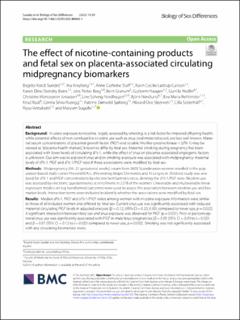| dc.contributor.author | Kordt Sundet, Birgitte | |
| dc.contributor.author | Kreyberg, Ina | |
| dc.contributor.author | Staff, Anne Cathrine | |
| dc.contributor.author | Carlsen, Karin Cecilie Lødrup | |
| dc.contributor.author | Bains, Karen Eline Stensby | |
| dc.contributor.author | Berg, Jens Petter | |
| dc.contributor.author | Granum, Berit | |
| dc.contributor.author | Haugen, Guttorm Nils | |
| dc.contributor.author | Hedlin, Gunilla | |
| dc.contributor.author | Jonassen, Christine M | |
| dc.contributor.author | Nordhagen, Live Solveig | |
| dc.contributor.author | Nordlund, Bjørn Kristian | |
| dc.contributor.author | Rehbinder, Eva Maria | |
| dc.contributor.author | Rudi, Knut | |
| dc.contributor.author | Rueegg, Corina Silvia | |
| dc.contributor.author | Sjøborg, Katrine Dønvold | |
| dc.contributor.author | Skjerven, Håvard Ove | |
| dc.contributor.author | Söderhäll, Cilla | |
| dc.contributor.author | Vettukattil, Muhammad Riyas | |
| dc.contributor.author | Sugulle, Meryam | |
| dc.date.accessioned | 2022-10-03T12:57:55Z | |
| dc.date.available | 2022-10-03T12:57:55Z | |
| dc.date.created | 2022-08-15T15:21:13Z | |
| dc.date.issued | 2022 | |
| dc.identifier.citation | Biology of Sex Differences. 2022, 13 (1), 1-10. | en_US |
| dc.identifier.issn | 2042-6410 | |
| dc.identifier.uri | https://hdl.handle.net/11250/3023391 | |
| dc.description | This article is licensed under a Creative Commons Attribution 4.0 International License, which permits use, sharing, adaptation, distribution and reproduction in any medium or format, as long as you give appropriate credit to the original author(s) and the source, provide a link to the Creative Commons licence, and indicate if changes were made. The images or other third party material in this article are included in the article’s Creative Commons licence, unless indicated otherwise in a credit line to the material. If material is not included in the article’s Creative Commons licence and your intended use is not permitted by statutory regulation or exceeds the permitted use, you will need to obtain permission directly from the copyright holder. To view a copy of this licence, visit http://creativecommons.org/licenses/by/4.0/. The Creative Commons Public Domain Dedication waiver (http://creativeco mmons.org/publicdomain/zero/1.0/) applies to the data made available in this article, unless otherwise stated in a credit line to the data | en_US |
| dc.description.abstract | Background: In utero exposure to nicotine, largely assessed by smoking, is a risk factor for impaired ofspring health, while potential efects of non-combustible nicotine use such as snus (oral moist tobacco), are less well-known. Maternal serum concentrations of placental growth factor (PlGF) and soluble fms-like tyrosine kinase-1 (sFlt-1) may be viewed as “placenta health markers”, known to difer by fetal sex. Maternal smoking during pregnancy has been associated with lower levels of circulating sFlt-1, while the efect of snus on placenta-associated angiogenic factors is unknown. Our aim was to explore if snus and/or smoking exposure was associated with midpregnancy maternal levels of sFlt-1, PlGF and sFlt-1/PlGF ratio if these associations were modifed by fetal sex.
Methods: Midpregnancy (16–22 gestational weeks) serum from 2603 Scandinavian women enrolled in the population-based multi-center PreventADALL (Preventing Atopic Dermatitis and ALLergies in children) study was analysed for sFlt-1 and PlGF concentrations by electrochemiluminescence, deriving the sFlt-1/PGF ratio. Nicotine use was assessed by electronic questionnaires at enrollment in 2278 of the women. Univariable and multivariable linear regression models on log transformed outcomes were used to assess the association between nicotine use and biomarker levels. Interaction terms were included to identify whether the associations were modifed by fetal sex.
Results: Median sFlt-1, PlGF and sFlt-1/PlGF ratios among women with nicotine exposure information were similar to those of all included women and difered by fetal sex. Current snus use was signifcantly associated with reduced maternal circulating PlGF levels in adjusted analyses [β−0.12, (95% CI−0.20; 0.00) compared to never use, p=0.020]. A signifcant interaction between fetal sex and snus exposure was observed for PIGF (p=0.031). Prior or periconceptional snus use was signifcantly associated with PIGF in male fetus pregnancies [β−0.05 (95% CI−0.09 to (−0.02)) and β−0.07 (95% CI−0.12 to (−0.02)) compared to never use, p=0.002]. Smoking was not signifcantly associated with any circulating biomarkers levels.
Conclusions: Midpregnancy maternal angiogenic profle difered by periconceptional snus use and fetal sex. Snus exposure, perceived as “safe” by users, before or during pregnancy seems to afect midpregnancy placental health in a sex dimorphic manner. | en_US |
| dc.language.iso | eng | en_US |
| dc.publisher | BioMed Central (BMC) | en_US |
| dc.rights | Navngivelse 4.0 Internasjonal | * |
| dc.rights.uri | http://creativecommons.org/licenses/by/4.0/deed.no | * |
| dc.subject | PreventADALL | en_US |
| dc.subject | fetal sex | en_US |
| dc.subject | nicotine | en_US |
| dc.subject | moist tobacco | en_US |
| dc.subject | placenta | en_US |
| dc.subject | angiogenic proteins | en_US |
| dc.title | The effect of nicotine-containing products and fetal sex on placenta-associated circulating midpregnancy biomarkers | en_US |
| dc.type | Peer reviewed | en_US |
| dc.type | Journal article | en_US |
| dc.description.version | publishedVersion | en_US |
| dc.rights.holder | © The Author(s) 2022. | en_US |
| dc.source.pagenumber | 1-10 | en_US |
| dc.source.volume | 13 | en_US |
| dc.source.journal | Biology of Sex Differences | en_US |
| dc.source.issue | 1 | en_US |
| dc.identifier.doi | 10.1186/s13293-022-00443-1 | |
| dc.identifier.cristin | 2043146 | |
| cristin.ispublished | true | |
| cristin.fulltext | original | |
| cristin.qualitycode | 1 | |

